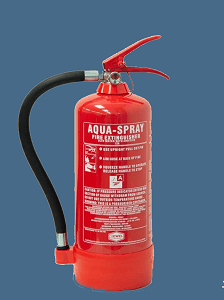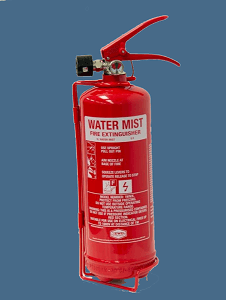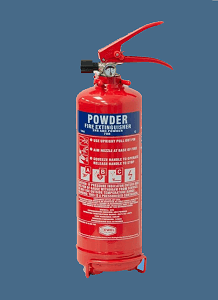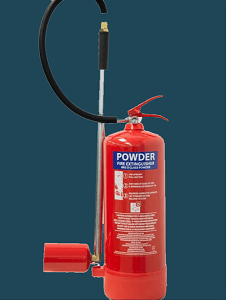Types of Fire ExtinguisherWhen it comes to securing our home or workplace against fire, we cannot ignore fire extinguishers. It is good to have fire extinguishers at home and office. Many countries have laws that fire extinguishers be kept as mandatory safety equipment. It is a great option for smaller or containable fires, preventing them from expanding into potential fire hazards. Due to the different types of fires, there are many fire extinguishers. It is important to know about their types and uses. This can help to distinguish the right one when we need it in an emergency. Therefore, in this article, we are discussing various important fire extinguisher types. Let us first understand about fire extinguishers: What is a Fire Extinguisher?Fire extinguisher refers to equipment or a device that can be used to combat a fire. Fire brigade individuals mainly use fire extinguishers to counter a variety of fires. However, these devices can be used by anyone with little training or a guide. According to fire concepts, fire usually spreads due to the simultaneous presence of fuel, heat sources, and air. Therefore, when we are fighting a fire, we need to remove any of these three resources. The purpose of a fire extinguisher is to cut such resources to overcome the fire. Understanding the classes of FireDifferent types of fire extinguishers are used to combat specific types of fire. Therefore, before we learn about different fire extinguishing types, we must understand different fire types. This will help us to select the right fire extinguisher in an emergency. We should always fight the fire carefully based on the material involved. Depending on the material or cause of the fire, it is usually classified into the following classes: Class A: Fire caused due to combustible carbon-based materials, such as wood, paper, plastic, textiles, etc. Class B: Fire caused due to flammable liquids, such as petrol, diesel, paint, paraffin, oils (other than cooking oils), etc. Class C: Fire caused due to flammable gases, such as butane, methane, propane, etc. Class D: Fire caused due to burning metals, such as lithium, sodium, potassium, magnesium, titanium, etc. Class E: Fire caused due to electrical equipment or sources (this class is typically a separate class in most countries and only referred to by an electric spark symbol instead of the letter 'E'). Class F: Fires caused due to cooking oils and fats, especially those used in deep-fat fryers. For example, olive oil, sunflower oil, vegetable oils, butter, etc. Typically, extinguishers have a sign based on the classes of fire they are best suitable for. The following image displays such indication signs of fire extinguisher: 
Types of Fire ExtinguishersDepending on usage or classes, fire extinguishers are quite different. Each type can be identified by their names, colors, signs, or even their nozzles/hoses. There are mainly five types of fire extinguishers, such as:
Let's discuss more about each type: Water ExtinguishersWater fire extinguishers are the most effective type of extinguishers to combat different types of fires. These fire extinguishers are mainly divided into the following two types:
Powder ExtinguishersPowder extinguishers are designed for multi-purpose use. Depending on the type of powder fire extinguishers, we can use them against Class A, Class B, Class C, Class D, and Class E fires. We can also use these extinguishers for electric fires; however, they are not as effective as other specific types because they do not cool the fire. This can sometimes cause a re-ignition of fire. Besides, they can reduce visibility due to their dust-like powder particles and also cause breathing problems. This is why the use of these fire extinguishers within a closed building is not recommended unless there is no other option. The power fire extinguishers are usually found in the following types:
Foam Extinguishers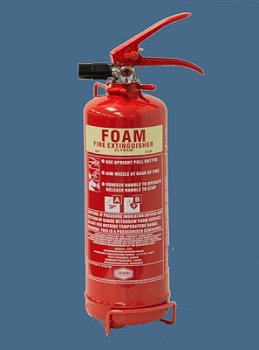
This type of fire extinguishers is identified by the word 'foam' printed across a cream-colored rectangle. Foam extinguishers are mainly based on the water; however, they are like foaming agents. This helps in smothering the flames and sealing vapors to stop the re-ignition of fire. These fire extinguishers are primarily used for Class A and Class B fires, especially for fires caused by solids and liquids. When using these extinguishers against Class A fires, we can point and spray the foaming solution directly into the fire or the origin. Besides, we shouldn't directly spray into the liquid when using against Class B fires (for fires caused by flammable liquids). This can result in the spreading of fire to the surrounding areas. The best method of application is to spray the foam into the fire areas to form a safety wall and prevent the flow of fire. Although we can use foam fire extinguishers for some electric fires, they are not recommended and should be used as the last option if they have di-electrical tests performed on them. Carbon Dioxide (CO2) Extinguishers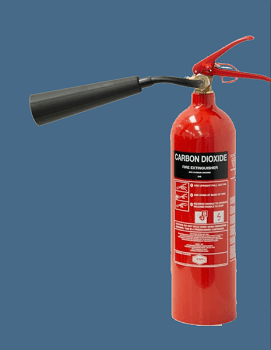
This type of fire extinguishers is distinguished by 'carbon dioxide' or 'CO2' written in white text on a black rectangle. They contain only pressurized CO2 gas and therefore leave no residue. They also have a specific type of tube. Carbon dioxide extinguishers are mainly used to counter Class B fires and electrical fires. CO2 gas works by suffocating a fire and does not harm electrical objects or cause a short circuit in the system. It usually suffocates the fire by displacing oxygen gas in the air. Because they don't leave any substance behind and therefore reduce damage to the electrical equipment. Besides, it is advised not to touch the horn, base, or pipework on the CO2 extinguishers while operating them. The gas becomes very cold during its release, which can damage our skin or even our hands. Wet Chemical Extinguishers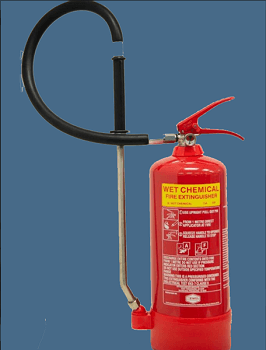
Wet chemical extinguishers are identified by the 'wet chemical' printed on a yellow rectangle. It comes with an extended hose that allows us to easily hold and point at the right position. This is mainly beneficial while trying to control fires on a kitchen top. These fire extinguishers are designed to combat Class F fire types. They are efficient because they are designed for notably high-temperature fires, especially due to fats and cooking oils. The wet chemical extinguisher consists of a pressurized solution of alkali salts in water, which, when used, generates a fine mist or soap-like solution. This helps dispel flames and prevent splashing. Besides, the solution cools the burning oil, seals the surface and prevents the fire's re-ignition. Although we may use wet fire extinguishers on Class A and some Class B fires (other than involving liquids fire), they are not effective like other relevant extinguishers. Instructions on how to use Fire ExtinguishersTo use a fire extinguisher, one must be properly trained. Most fire extinguishers are designed to be operated using the P.A.S.S. (Pull, aim, squeeze, sweep) method: Pull: Find the pin on the fire extinguisher and pull it to break the tamper seal. Aim: Keep the fire extinguisher low, pointing to the nozzle at the origin of the fire. Squeeze: Squeeze the handle on top of the extinguisher to release the extinguishing material. Sweep: Sweep the nozzle from one side to the other sides at the fire's base until the fire is extinguished. It would be more useful to use a fire extinguisher practically instead of just reading the text and thinking of it as training. It is highly recommended to take training from an authorized person. Note: Fire buckets, hoses and blankets can also be useful as additions with fire extinguishers, but we should use them carefully. Fire hoses and buckets filled with water can be beneficial on Class A fires; however, we must never use them on burning oil, fat and electrical appliances. Additionally, fire buckets filled with sand can be beneficial on Class B fires (on flammable liquids). Besides, the blankets can be used on small, contained fires.
Next TopicTypes of Vitamins
|
 For Videos Join Our Youtube Channel: Join Now
For Videos Join Our Youtube Channel: Join Now
Feedback
- Send your Feedback to [email protected]
Help Others, Please Share




